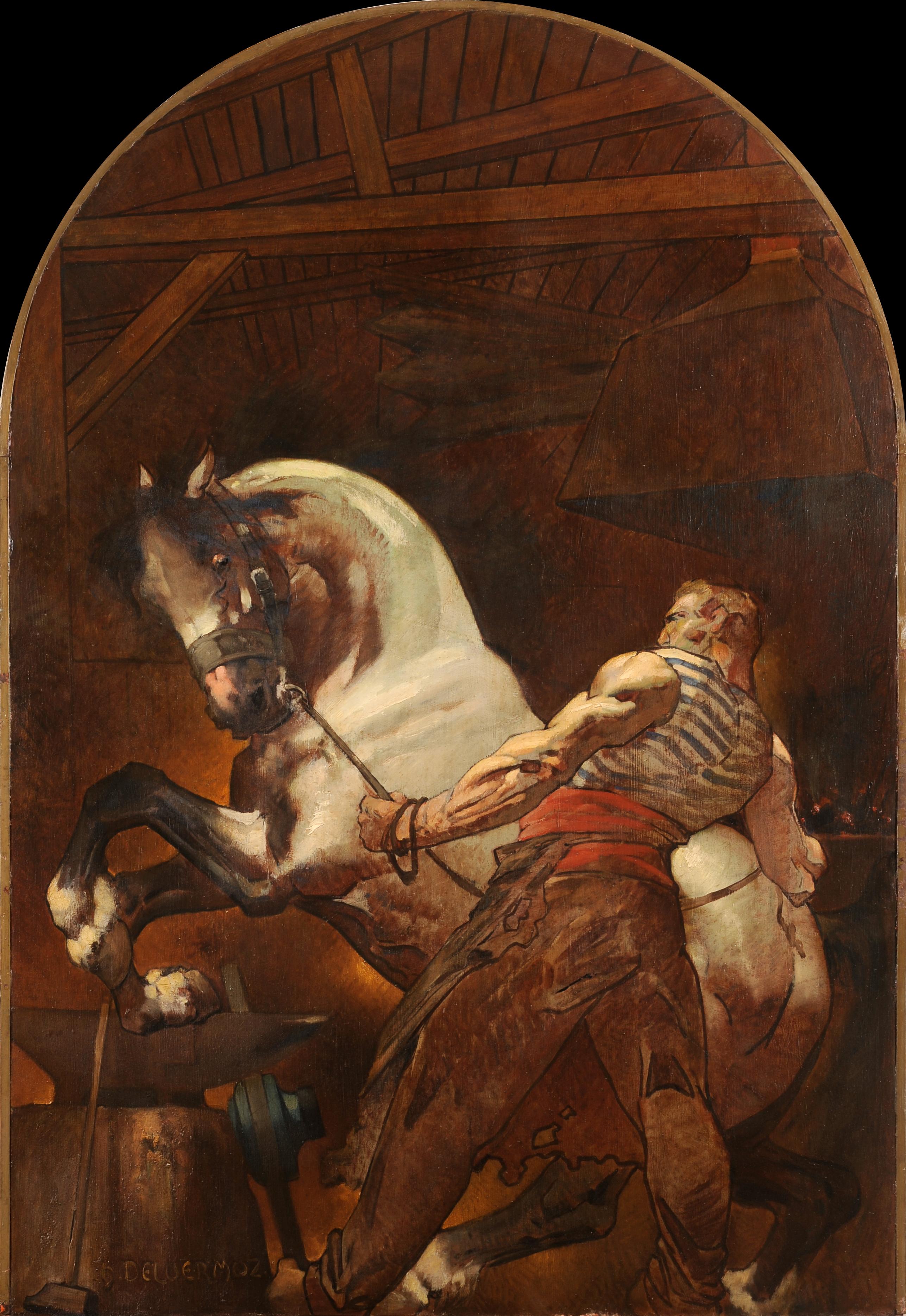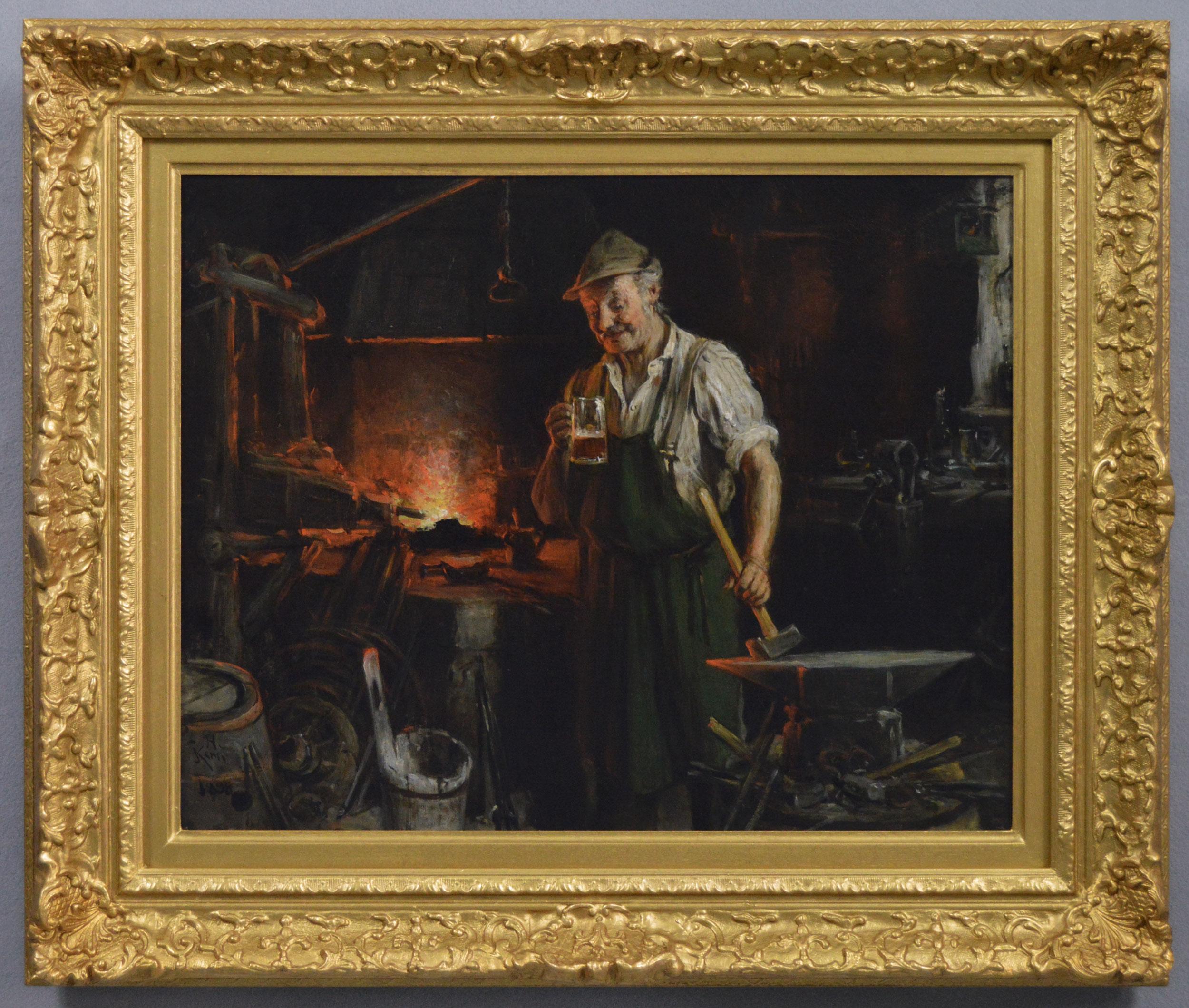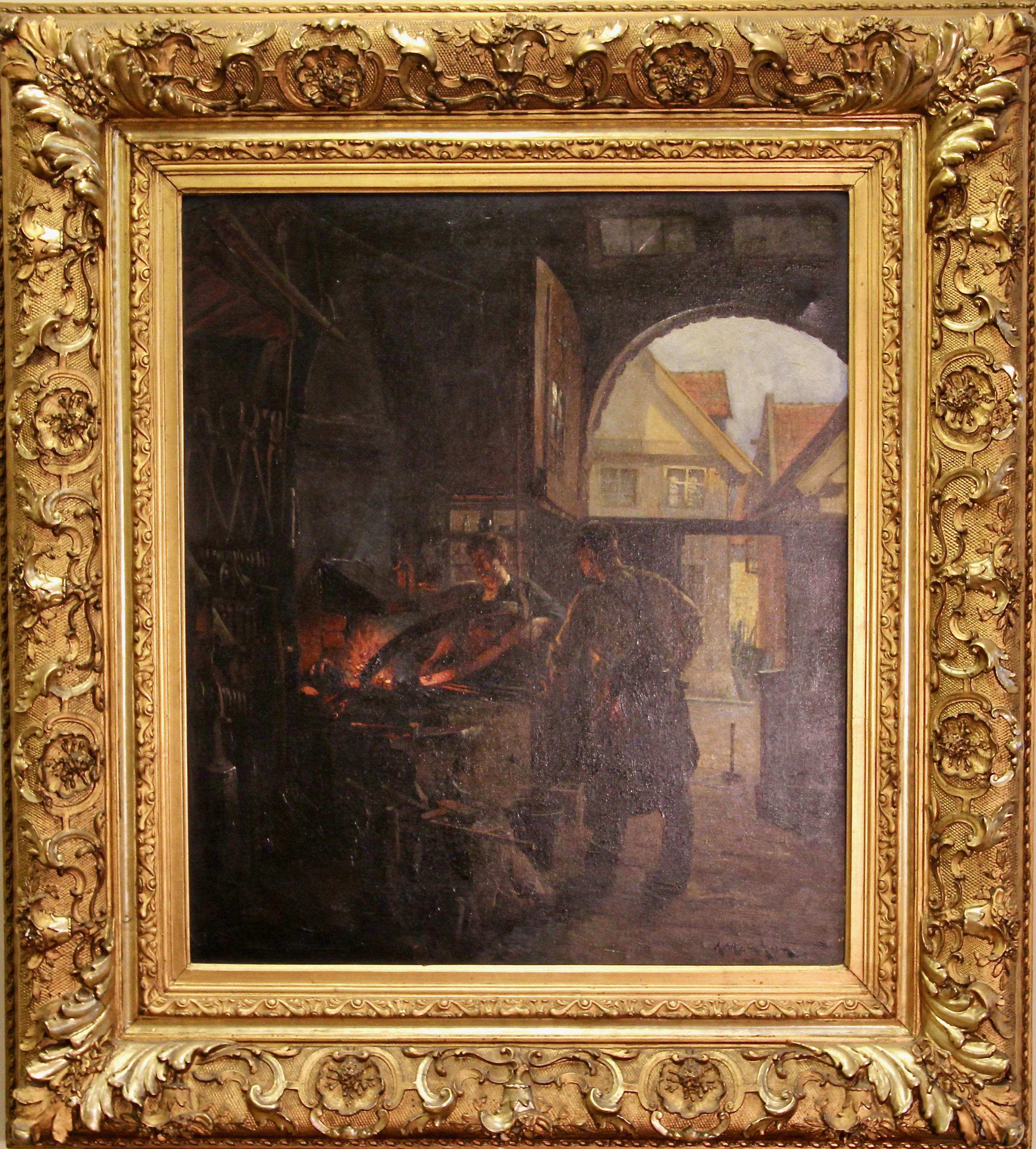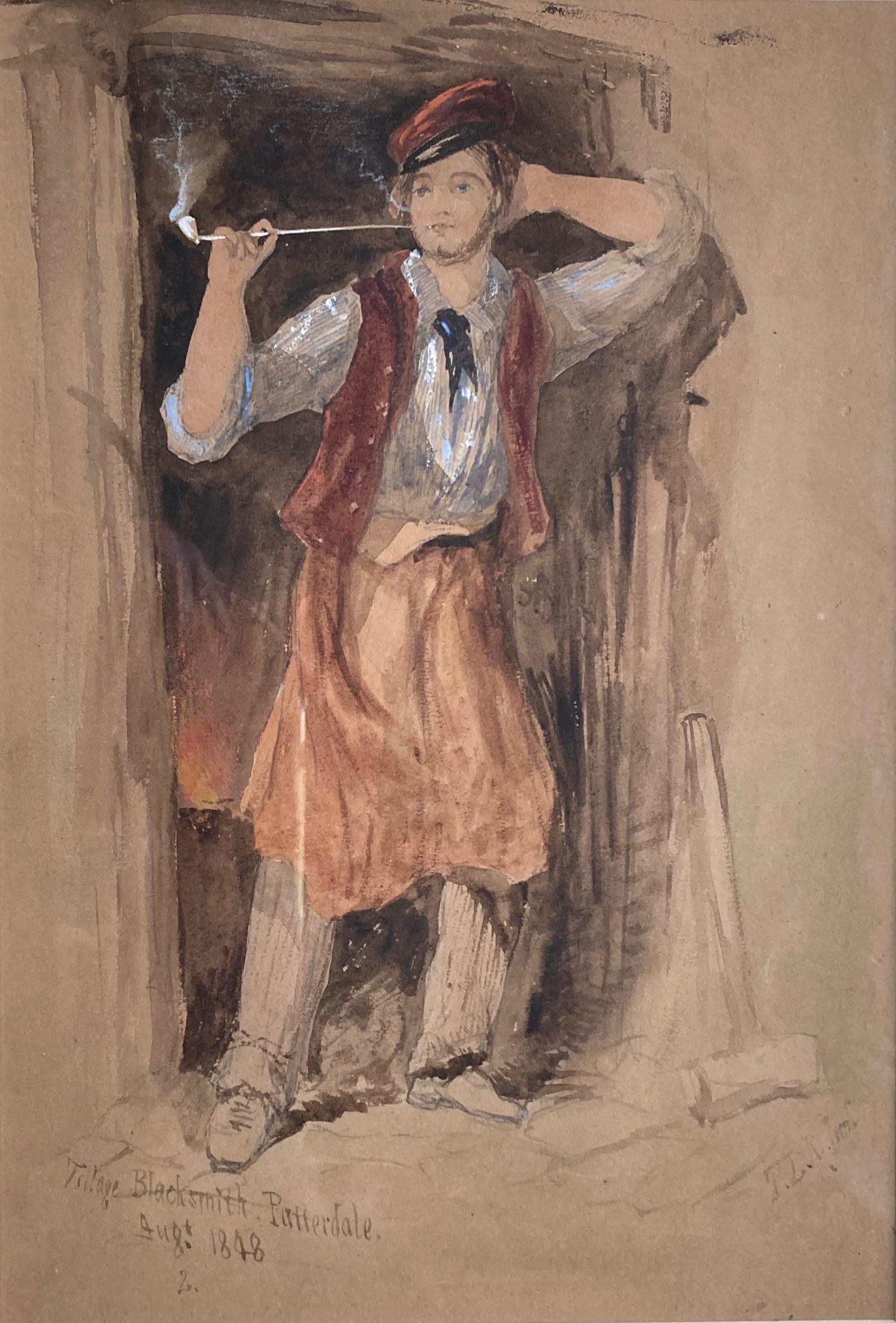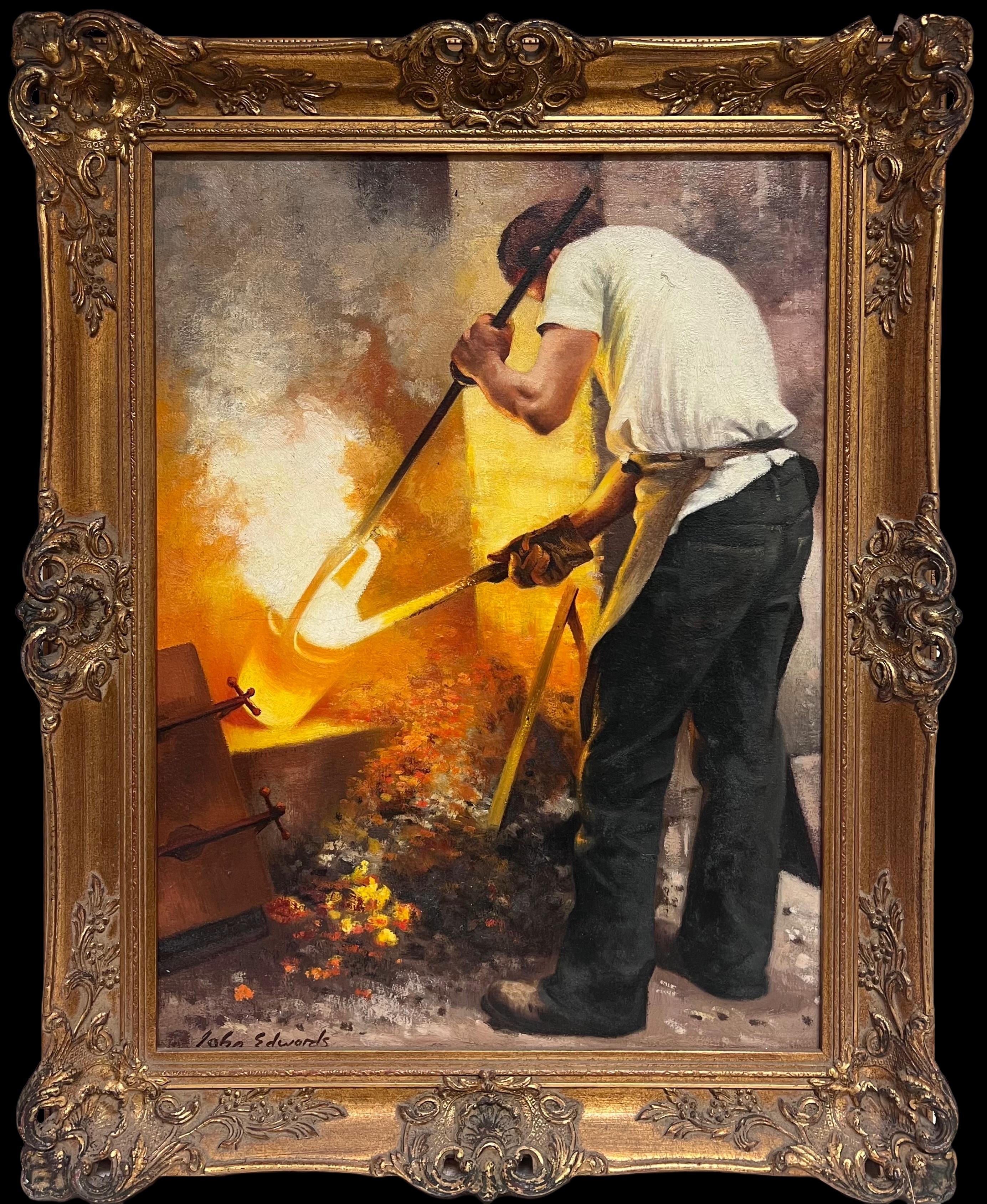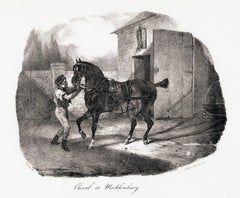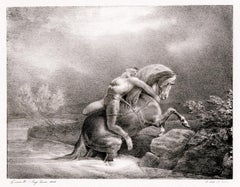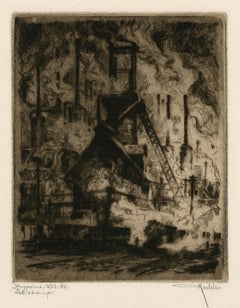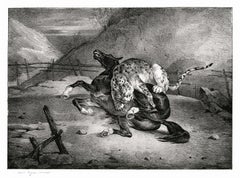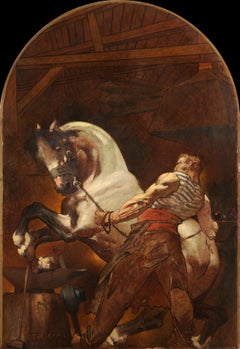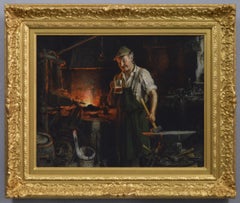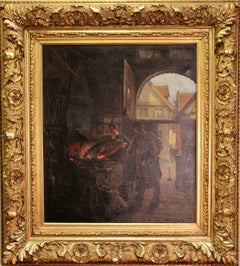Items Similar to 'Le maréchal flamand' (The Flemish Blacksmith) — 19th-Century French Romanticism
Want more images or videos?
Request additional images or videos from the seller
1 of 3
'Le maréchal flamand' (The Flemish Blacksmith) — 19th-Century French Romanticism1822
1822
$1,400
£1,069.38
€1,228.84
CA$1,998.51
A$2,191.21
CHF 1,144.23
MX$26,368.45
NOK 14,421.22
SEK 13,559.66
DKK 9,177.16
About the Item
Théodore Géricault 'Le maréchal flamand' (The Flemish Blacksmith) from the series ‘Etudes, de chevaux lithographiés,’ lithograph, 1822, 2nd state of 2, Delteil 85. With the lettered inscription: 'Géricault del', 'Chez Gihaut, éditeur, Md. d'Estampes, b.ard des Italiens, No 5'. The lithographic rendering was completed in large part by Léon Cogniet. Published by Gihaut Frères, Paris.
A fine, richly-inked impression, on off-white, wove paper, with wide margins (2 1/2 to 4 1/2 inches) in excellent condition. Matted to museum standards, unframed.
Image size 9 5/8 x 12 3/4 inches (245 x 324 mm); sheet size 15 1/4 x 21 1/8 inches (387 x 537 mm).
Impressions of this work are held in the following collections: Art Gallery NSW, Art Institute of Chicago, British Museum, Harvard Art Museums, Metropolitan Museum of Art, National Gallery of Art, Princeton University Art Museum, RISD Museum, Virginia Museum of Fine Arts, Yale University Art Gallery.
ABOUT THE ARTIST
Géricault's fiery, audacious personality and short life fit the mold of Romantic artists of his era and, along with his controversial paintings, profoundly influenced nineteenth-century art. Notwithstanding about three years of studio training, Géricault was largely self-taught. He copied paintings in the Louvre and traveled to Rome, where he discovered Michelangelo's works and the exuberance of Baroque art.
In his enormous 'Raft of the Medusa,' now at the Louvre, Géricault fused Realism and Romanticism, elevating a current event—a shipwreck with few survivors—to the status of monumental art. To achieve authenticity, he used a model of the raft and carefully studied real cadavers—even his friend, Eugène Delacroix, posed for one of the figures. The wreck was attributed to governmental negligence and corruption and the resulting controversy, combined with the painting's veracity, brought Géricault widespread attention.
Géricault was also a master of lithography, the sole printmaking medium he employed to produce his breathtaking representations of horses and military subjects, two of his lifelong passions. During his English sojourn of 1820-21, Géricault improved his knowledge of the lithographic technique in the London workshop of Charles Joseph Hullmandel. The most striking result of this experience was the series of twelve lithographs, ‘Various Subjects Drawn from Life and on Stone’, also known as ‘The English Set.’ Géricault continued his studies of the horse once he was back in France, producing the renowned series ‘Etudes, de chevaux lithographiés,’ from which we offer this featured work.
Géricault died in 1824 at age thirty-two after a prolonged illness caused by a riding accident. His last major works, discovered almost fifty years after his death, were penetrating portraits of the insane. Like the 'Raft of the Medusa,' they offered a new concept of appropriate subject matter for serious painting.
Gericault's lithographs are held in numerous museums in Europe, Britain, and the United States including The Art Institute of Chicago, The Getty Museum (Los Angeles), The Metropolitan Museum of Art (New York), The Morgan Library & Museum (New York), The Museum of Fine Arts, Boston, The National Gallery of Art (Washington D.C., The National Gallery (London), The British Museum (London), The Wallace Collection (London), The Louvre Museum (Paris), Musée des Beaux-Arts de Lyon (Lyon), Musée Fabre (Montpellier, France), Kunsthalle Hamburg (Hamburg, Germany), Alte Pinakothek (Munich, Germany), Musée Royal des Beaux-Arts de Belgique (Brussels, Belgium), and the Hermitage Museum (St. Petersburg, Russia).
- Creation Year:1822
- Dimensions:Height: 9.63 in (24.47 cm)Width: 12.75 in (32.39 cm)
- Medium:
- Movement & Style:
- After:Jean Louis Andre Theodore Gericault (1791 - 1824, French)
- Period:
- Condition:
- Gallery Location:Myrtle Beach, SC
- Reference Number:Seller: 1039131stDibs: LU532310339472
About the Seller
5.0
Recognized Seller
These prestigious sellers are industry leaders and represent the highest echelon for item quality and design.
Platinum Seller
Premium sellers with a 4.7+ rating and 24-hour response times
Established in 1995
1stDibs seller since 2016
324 sales on 1stDibs
Typical response time: 1 hour
Associations
International Fine Print Dealers Association
- ShippingRetrieving quote...Shipping from: Myrtle Beach, SC
- Return Policy
Authenticity Guarantee
In the unlikely event there’s an issue with an item’s authenticity, contact us within 1 year for a full refund. DetailsMoney-Back Guarantee
If your item is not as described, is damaged in transit, or does not arrive, contact us within 7 days for a full refund. Details24-Hour Cancellation
You have a 24-hour grace period in which to reconsider your purchase, with no questions asked.Vetted Professional Sellers
Our world-class sellers must adhere to strict standards for service and quality, maintaining the integrity of our listings.Price-Match Guarantee
If you find that a seller listed the same item for a lower price elsewhere, we’ll match it.Trusted Global Delivery
Our best-in-class carrier network provides specialized shipping options worldwide, including custom delivery.More From This Seller
View All'Cheval de Mecklembourg' — 19th-Century French Romanticism
By Jean Louis Andre Theodore Gericault
Located in Myrtle Beach, SC
Théodore Géricault 'Cheval de Mecklembourg' (Mecklembourg Horse), lithograph, 1822, 2nd state of 4, Delteil 47. Signed in the matrix 'Gericault', lower left. Published by Godefroy En...
Category
1820s Romantic Animal Prints
Materials
Lithograph
'Mazeppa' — 19th-Century French Romanticism
By Jean Louis Andre Theodore Gericault
Located in Myrtle Beach, SC
Théodore Géricault and Eugène Lami, 'Mazeppa' from the series 'Oeuvres de Lord Byron', lithograph, 1823, 2nd state of 3, Delteil 94. Rendered by Thé...
Category
1820s Romantic Animal Prints
Materials
Lithograph
'The Furnace' — American Expressionism
By Otto Kuhler
Located in Myrtle Beach, SC
Otto Kuhler, 'The Furnace', drypoint, edition 26, 1924, Kennedy 5. Signed and annotated 'Drypoint. Ltd Ed. Del. et imp.' in pencil. Titled in pencil, in the bottom center sheet edge....
Category
1920s American Modern Figurative Prints
Materials
Drypoint
'Horse Attacked by Tiger' — 19th-Century French Romanticism
By Jean Louis Andre Theodore Gericault
Located in Myrtle Beach, SC
Théodore Géricault (after), 'Tigre dévorant un cheval' (Tiger Devouring a Horse), lithograph, 3rd state of 3, Clement 97, c. 1820. Lettered 'Volmar ...
Category
1820s Romantic Animal Prints
Materials
Lithograph
'The Death of Hercules' from 'The Temple of the Muses' — 18th Century Engraving
By Bernard Picart
Located in Myrtle Beach, SC
Bernard Picart, 'The Death of Hercules' from 'The Temple of the Muses', engraving, 1730. Signed in the plate, lower left. Titled in French, English, German, and Dutch. A superb, rich...
Category
1730s Baroque Figurative Prints
Materials
Engraving
'Taos - Relic of the Insurrection of 1845' — Southwest Regionalism
By Ira Moskowitz
Located in Myrtle Beach, SC
Ira Moskowitz, 'Relic of the Insurrection of 1845' also 'Taos Pueblo with Ruin)', lithograph, 1944, edition 30, Czestochowski 121. Signed and titled in pencil. Signed and dated in the stone, lower right. A fine, richly-inked impression, on cream wove paper, with full margins (1 3/8 to 1 15/16 inches). Very pale light toning within a previous mat opening, otherwise in excellent condition. Matted to museum standards, unframed.
Image size 11 5/8 x 15 1/2 inches (296 x 394 mm); sheet size 15 1/8 x 19 inches (384 x 483 mm).
ABOUT THE IMAGE
The Taos Revolt was a populist insurrection in January 1847 by Hispano and Pueblo allies against the United States occupation of present-day northern New Mexico during the Mexican–American War. The rebels killed provisional governor Charles Bent and several other Americans. In two short campaigns, United States troops and militia crushed the rebellion of the Hispano and Pueblo people. The New Mexicans, seeking better representation, regrouped and fought three more engagements, but after being defeated, they abandoned open warfare. The hatred of New Mexicans for the occupying American army, combined with the rebelliousness of Taos residents against imposed outside authority, were causes of the revolt. In the uprising's aftermath, the Americans executed at least 28 rebels. The Treaty of Guadalupe Hidalgo in 1850 guaranteed the property rights of New Mexico's Hispanic and American Indian residents.
ABOUT THE ARTIST
Ira Moskowitz was born in Galicia, Poland, in 1912, emigrating with his family to New York in 1927. He enrolled at the Art Student's League and studied there from 1928-31. In 1935, Moskowitz traveled to Paris and then lived until 1937 in what is now Israel. He returned to the United States in 1938 to marry artist Anna Barry in New York. The couple soon visited Taos and Santa Fe in New Mexico, returning for extended periods until 1944, when they moved there permanently, staying until 1949. During this especially productive New Mexico period, Moskowitz received a Guggenheim fellowship. His work was inspired by the New Mexico landscape and the state’s three cultures (American Southwest, Native American, and Mexican). He focused on Pueblo and Navajo life, producing an extensive oeuvre of authentic American Indian imagery. He and Anna also visited and sketched across the border in Old Mexico. While in the Southwest, Moskowitz flourished as a printmaker while continuing to produce oils and watercolors. Over 100 of Moskowitz’s works depicting Native American ceremonies were used to illustrate the book American Indian Ceremonial Dances by John Collier, Crown Publishers, New York, 1972.
After leaving the Southwest, printmaking remained an essential medium for the artist while his focus changed to subject matter celebrating Judaic religious life and customs. These works were well received early on, and Moskowitz was content to stay with them the rest of his life. From 1963 until 1966, Moskowitz lived in Paris, returning to New York City in 1967, where he made his permanent home until he died in 2001.
Shortly before his death, Zaplin-Lampert Gallery of Santa Fe staged an exhibition of the artist's works, December 2000 - January 2001. Other one-person shows included the 8th Street Playhouse, New York, 1934; Houston Museum, 1941; and the San Antonio Museum, 1941. The artist’s work was included in exhibitions at the Art Students League, Art Institute of Chicago, Philadelphia Print Club, College Art Association (promotes excellence in scholarship and teaching), and the International Exhibition of Graphic Arts (shown at MOMA, 1955).
Moskowitz’s lithographs of American Indian...
Category
1940s American Modern Landscape Prints
Materials
Lithograph
You May Also Like
Marechal Ferrant (The Blacksmith)
By Hermine David
Located in New York, NY
Hermine David (1886-1970), Marechal Ferrant (The Blacksmith), etching and drypoint, signed in pencil lower right [also signed in the plate lower left], ...
Category
1920s Modern Figurative Prints
Materials
Drypoint, Etching
Horse at the Blacksmith's
By Louis Henri Deluermoz
Located in BELEYMAS, FR
Henri DELUERMOZ
(Paris 1876 – Paris 1943)
At the blacksmith's
Oil on metal. Two welded plates
H. 145 cm; W. 100.5 cm
Signed lower left
Trained under Alcide-Joseph Lorentz and Charle...
Category
1890s French School Portrait Paintings
Materials
Metal
19th Century genre oil painting of a blacksmith at a forge
Located in Nr Broadway, Worcestershire
Hermann Armin Kern
Hungarian (1839-1912)
The Blacksmith
Oil on canvas, signed & dated 1898, with wax seal to reverse
Image size: 16 inches x 20.25 inches
Size including frame: 23.5 ...
Category
Late 19th Century Victorian Figurative Paintings
Materials
Oil, Canvas
Oil Painting by Anders Montan, "In the Forge, Smithery, Blacksmith" 19th Century
Located in Berlin, DE
Very decorative oil painting by Anders Montan, in the forge, 19th century
Signed lower right. Famous Swedish artist.
Dimensions with frame: 104 cm x 11...
Category
19th Century Figurative Paintings
Materials
Canvas, Oil
$9,008 Sale Price
20% Off
Thomas Leeson Rowbotham, Victorian blacksmith
By Thomas Charles Leeson Rowbotham
Located in Harkstead, GB
A really charming study of a blacksmith puffing on a clay pipe at the forge door.
Thomas Charles Leeson Rowbotham Junr (1823-1875)
Village Blacksmith Patterdale, Aug 1848
Signed, in...
Category
Mid-19th Century Victorian Figurative Drawings and Watercolors
Materials
Paper, Watercolor
$452 Sale Price
42% Off
The Blacksmiths Forge Traditional English Rural Life Portrait Oil Painting
Located in Cirencester, Gloucestershire
The Blacksmith
by John Edwards (England, 1940 - 2020)
signed oil on canvas, framed
framed: 29 x 23.5 inches
canvas : 23 x 18 inches
Provenance: private collection, UK
Condition: very...
Category
Mid-20th Century Victorian Portrait Paintings
Materials
Oil
More Ways To Browse
The Blacksmith
French 19th Century Lithographs
Antique St Petersburg Russia
Military Horse
French Marechal
Flamingo Prints Vintage
Vintage Circus Animals
John Bowen
Sea Bird Art
Antique Crab Print
Camera Lucida
Chris Forrest
Intaglio Bird
Jacques Antiques
White Line Woodcut
Charles Schulz
Etchings Of Horses
Race Horse Print
